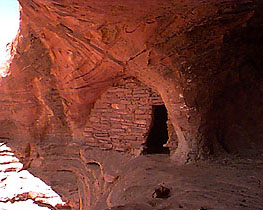


|
The focus of our trip to the southwest is rocks, and more specifically, the markings left on them by ancient peoples. Our final desination is southeastern Colorado, where we have been invited to look at inscriptions which may have been written in an extinct language, known to be the tongue of Indo-Europeans many thousands of years before Christopher Columbus made his discovery of the new world.
In our travels, we will stop at various sites known to be inhabited by the ancient indian tribes of Four Corners and examine some of the structures and symbols left behind by them. We'll also talk with some members of the Navajo and Hopi tribes who have lived in this area for centuries.
A Brief History
Several hundred years B.C., native cultures in the southwest were comprised of three groups: the Mongollon, the Hohokam and the Anasazi (the name given by the Navajo who now inhabit the land). The Mongollon are usually credited with the introduction of farming and the cultivation of corn, squash, potatoes, beans, tomatoes and strawberries. They were the innovators of the circular pit houses, or kiva, that eventually characterized all of the Desert Tradition indians.
The Mongollon pottery started as plain red and brown, then progressed into red on white and black on white designs bearing stylized figures of people and animals. This pottery style, like much of their culture, was absorbed, along with Hohokam contributions, into the flourishing Anasazi nation.
The Hohokam people were expert artisans. They were also great engineers, creating canals and irrigating much of what is now the Phoenix, Arizona area. Their pottery was also embellished and they created many clay figurines that showed heavily influenced Mexican styles and designs.
|

 The Anasazi ruins show that they lived in a tight community, in what appear to have been apartments. There were several underground circular chambers, or kiva, and archaeological data shows that they cultivated cotton and made fabric. One outstanding characteristic of the Anasazi people was their ability to live peacefully with their surrounding tribes and to assimilate unique skills and survival techniques into their own culture.
The Anasazi ruins show that they lived in a tight community, in what appear to have been apartments. There were several underground circular chambers, or kiva, and archaeological data shows that they cultivated cotton and made fabric. One outstanding characteristic of the Anasazi people was their ability to live peacefully with their surrounding tribes and to assimilate unique skills and survival techniques into their own culture.